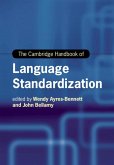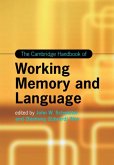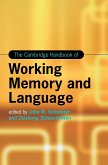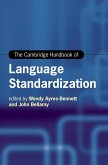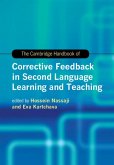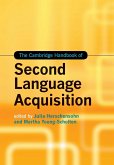The Cambridge Handbook of Language and Brain
Herausgeber: Andrews, Edna; Kiran, Swathi
The Cambridge Handbook of Language and Brain
Herausgeber: Andrews, Edna; Kiran, Swathi
- Gebundenes Buch
- Merkliste
- Auf die Merkliste
- Bewerten Bewerten
- Teilen
- Produkt teilen
- Produkterinnerung
- Produkterinnerung
Bringing together contributions from internationally renowned scholars, this Handbook provides a complete guide to research in the field of language and the brain. It is essential reading for researchers and students in the fields of neurolinguistics, language and the brain and cognitive linguistics, and also neuroscience and cognitive psychology.
Andere Kunden interessierten sich auch für
![The Cambridge Handbook of Language Standardization The Cambridge Handbook of Language Standardization]() The Cambridge Handbook of Language Standardization44,99 €
The Cambridge Handbook of Language Standardization44,99 €![The Cambridge Handbook of Working Memory and Language The Cambridge Handbook of Working Memory and Language]() The Cambridge Handbook of Working Memory and Language45,99 €
The Cambridge Handbook of Working Memory and Language45,99 €![The Cambridge Handbook of Working Memory and Language The Cambridge Handbook of Working Memory and Language]() The Cambridge Handbook of Working Memory and Language149,99 €
The Cambridge Handbook of Working Memory and Language149,99 €![The Cambridge Handbook of Language Standardization The Cambridge Handbook of Language Standardization]() The Cambridge Handbook of Language Standardization150,99 €
The Cambridge Handbook of Language Standardization150,99 €![The Cambridge Handbook of Corrective Feedback in Second Language Learning and Teaching The Cambridge Handbook of Corrective Feedback in Second Language Learning and Teaching]() The Cambridge Handbook of Corrective Feedback in Second Language Learning and Teaching44,99 €
The Cambridge Handbook of Corrective Feedback in Second Language Learning and Teaching44,99 €![The Cambridge Handbook of Language Contact The Cambridge Handbook of Language Contact]() The Cambridge Handbook of Language Contact54,99 €
The Cambridge Handbook of Language Contact54,99 €![The Cambridge Handbook of Second Language Acquisition The Cambridge Handbook of Second Language Acquisition]() The Cambridge Handbook of Second Language Acquisition56,99 €
The Cambridge Handbook of Second Language Acquisition56,99 €-
-
-
Bringing together contributions from internationally renowned scholars, this Handbook provides a complete guide to research in the field of language and the brain. It is essential reading for researchers and students in the fields of neurolinguistics, language and the brain and cognitive linguistics, and also neuroscience and cognitive psychology.
Produktdetails
- Produktdetails
- Cambridge Handbooks in Language and Linguistics
- Verlag: Cambridge University Press
- Seitenzahl: 568
- Erscheinungstermin: 1. September 2025
- Englisch
- Abmessung: 250mm x 175mm x 35mm
- Gewicht: 1140g
- ISBN-13: 9781009202282
- ISBN-10: 1009202286
- Artikelnr.: 72176296
- Herstellerkennzeichnung
- Libri GmbH
- Europaallee 1
- 36244 Bad Hersfeld
- gpsr@libri.de
- Cambridge Handbooks in Language and Linguistics
- Verlag: Cambridge University Press
- Seitenzahl: 568
- Erscheinungstermin: 1. September 2025
- Englisch
- Abmessung: 250mm x 175mm x 35mm
- Gewicht: 1140g
- ISBN-13: 9781009202282
- ISBN-10: 1009202286
- Artikelnr.: 72176296
- Herstellerkennzeichnung
- Libri GmbH
- Europaallee 1
- 36244 Bad Hersfeld
- gpsr@libri.de
Part I. Introduction: Theoretical Foundations of Language and Brain: 1. At
the crossroads of the study of language and brain in healthy subjects and
in pathology: foundational questions through an innovative lens (Deepening
of the analysis of networks crucial for language processing: Questions,
theory, application) Edna Andrews and Swathi Kiran; Part II. Neuroimaging
Studies of Brain and Language: Hemodynamic and Electrophysiological
Studies: 2. Neuroimaging of cognitive reserve in bilinguals Federico Gallo
and Jubin Abutalebi; 3. Networks and multimodalities underlying language
processing in the brain: evidence from structural and functional
neuroimaging Edna Andrews and Charlotte Sophia Rammell; 4. TMS as a tool
for mapping the dynamic properties of language in the brain Harsheen Kaur,
Gerald Grant and Fiona Baumer; Part III. Language and Cognitive
Development: 5. Functional connectivity and recovery from Aphasia Tali
Bitan; 6. Recent developments in psycholinguistics and neurolinguistics
through the lens of Aphasia Erin L. Meier and Chaleece W. Sandberg; 7. The
default mode network and language impairment in stroke and
neurodegeneration E. Susan Duncan, Aswathy Anakkathil Pradeep, Juhi Kidwai
and Adam Buchwald; 8. Language and cognition Sarah Villard, Lauryn Zipse,
and Sofia Vallila-Rohter; Prediction in language processing: some ideas
about how it's done Matthew J. Traxler and Tamara Y. Swaab; Part IV. Brain
and Languages: A. Building Cognitive Brain Reserve and the Importance of
Proficiency: 10. Bilingualism as a dynamic experience and its effects on
brain structure, function and metabolism Christos Pliatsikas; 11. Factors
in variable outcomes in second language acquisition David Birdsong; 12.
Longitudinal fMRI analyses of second language acquisition: expanding the
repertoire of imaging techniques and proficiency measures in future studies
Edna Andrews and Alexandria Swaine; 13. Cognitive and neural aspects of the
multilingual mental lexicon John Schwieter and Gabrielle Klassen; B.
Aphasia and Autism Spectrum Disorders: 14. Language control in bilingual
aphasia Teresa Gray and Arpita Bose; 15. Neural foundations of language in
autism spectrum disorder Meredith Pecukonis, Lindsay Butler, Charlotte
Gaynor, and Helen Tager-Flusberg; Part V. Brain, Language and Music: 16.
Neuroplastic effects of music expertise on speech-language processing Gavin
M. Bidelman, Jane A. Brown, Rose Rizzi, and Jessica MacLean; 17. Music and
language in the brain: balancing domain-specific and domain-general
mechanisms Stephen C. Van Hedger and Urvi Maheshwari; Part VI. New
Directions and Perspectives: 18. Hippocampal dependent memory supports
communication and language: Implications for cognitive-communication
disorders Melissa C. Duff and Natalie V. Covington.
the crossroads of the study of language and brain in healthy subjects and
in pathology: foundational questions through an innovative lens (Deepening
of the analysis of networks crucial for language processing: Questions,
theory, application) Edna Andrews and Swathi Kiran; Part II. Neuroimaging
Studies of Brain and Language: Hemodynamic and Electrophysiological
Studies: 2. Neuroimaging of cognitive reserve in bilinguals Federico Gallo
and Jubin Abutalebi; 3. Networks and multimodalities underlying language
processing in the brain: evidence from structural and functional
neuroimaging Edna Andrews and Charlotte Sophia Rammell; 4. TMS as a tool
for mapping the dynamic properties of language in the brain Harsheen Kaur,
Gerald Grant and Fiona Baumer; Part III. Language and Cognitive
Development: 5. Functional connectivity and recovery from Aphasia Tali
Bitan; 6. Recent developments in psycholinguistics and neurolinguistics
through the lens of Aphasia Erin L. Meier and Chaleece W. Sandberg; 7. The
default mode network and language impairment in stroke and
neurodegeneration E. Susan Duncan, Aswathy Anakkathil Pradeep, Juhi Kidwai
and Adam Buchwald; 8. Language and cognition Sarah Villard, Lauryn Zipse,
and Sofia Vallila-Rohter; Prediction in language processing: some ideas
about how it's done Matthew J. Traxler and Tamara Y. Swaab; Part IV. Brain
and Languages: A. Building Cognitive Brain Reserve and the Importance of
Proficiency: 10. Bilingualism as a dynamic experience and its effects on
brain structure, function and metabolism Christos Pliatsikas; 11. Factors
in variable outcomes in second language acquisition David Birdsong; 12.
Longitudinal fMRI analyses of second language acquisition: expanding the
repertoire of imaging techniques and proficiency measures in future studies
Edna Andrews and Alexandria Swaine; 13. Cognitive and neural aspects of the
multilingual mental lexicon John Schwieter and Gabrielle Klassen; B.
Aphasia and Autism Spectrum Disorders: 14. Language control in bilingual
aphasia Teresa Gray and Arpita Bose; 15. Neural foundations of language in
autism spectrum disorder Meredith Pecukonis, Lindsay Butler, Charlotte
Gaynor, and Helen Tager-Flusberg; Part V. Brain, Language and Music: 16.
Neuroplastic effects of music expertise on speech-language processing Gavin
M. Bidelman, Jane A. Brown, Rose Rizzi, and Jessica MacLean; 17. Music and
language in the brain: balancing domain-specific and domain-general
mechanisms Stephen C. Van Hedger and Urvi Maheshwari; Part VI. New
Directions and Perspectives: 18. Hippocampal dependent memory supports
communication and language: Implications for cognitive-communication
disorders Melissa C. Duff and Natalie V. Covington.
Part I. Introduction: Theoretical Foundations of Language and Brain: 1. At
the crossroads of the study of language and brain in healthy subjects and
in pathology: foundational questions through an innovative lens (Deepening
of the analysis of networks crucial for language processing: Questions,
theory, application) Edna Andrews and Swathi Kiran; Part II. Neuroimaging
Studies of Brain and Language: Hemodynamic and Electrophysiological
Studies: 2. Neuroimaging of cognitive reserve in bilinguals Federico Gallo
and Jubin Abutalebi; 3. Networks and multimodalities underlying language
processing in the brain: evidence from structural and functional
neuroimaging Edna Andrews and Charlotte Sophia Rammell; 4. TMS as a tool
for mapping the dynamic properties of language in the brain Harsheen Kaur,
Gerald Grant and Fiona Baumer; Part III. Language and Cognitive
Development: 5. Functional connectivity and recovery from Aphasia Tali
Bitan; 6. Recent developments in psycholinguistics and neurolinguistics
through the lens of Aphasia Erin L. Meier and Chaleece W. Sandberg; 7. The
default mode network and language impairment in stroke and
neurodegeneration E. Susan Duncan, Aswathy Anakkathil Pradeep, Juhi Kidwai
and Adam Buchwald; 8. Language and cognition Sarah Villard, Lauryn Zipse,
and Sofia Vallila-Rohter; Prediction in language processing: some ideas
about how it's done Matthew J. Traxler and Tamara Y. Swaab; Part IV. Brain
and Languages: A. Building Cognitive Brain Reserve and the Importance of
Proficiency: 10. Bilingualism as a dynamic experience and its effects on
brain structure, function and metabolism Christos Pliatsikas; 11. Factors
in variable outcomes in second language acquisition David Birdsong; 12.
Longitudinal fMRI analyses of second language acquisition: expanding the
repertoire of imaging techniques and proficiency measures in future studies
Edna Andrews and Alexandria Swaine; 13. Cognitive and neural aspects of the
multilingual mental lexicon John Schwieter and Gabrielle Klassen; B.
Aphasia and Autism Spectrum Disorders: 14. Language control in bilingual
aphasia Teresa Gray and Arpita Bose; 15. Neural foundations of language in
autism spectrum disorder Meredith Pecukonis, Lindsay Butler, Charlotte
Gaynor, and Helen Tager-Flusberg; Part V. Brain, Language and Music: 16.
Neuroplastic effects of music expertise on speech-language processing Gavin
M. Bidelman, Jane A. Brown, Rose Rizzi, and Jessica MacLean; 17. Music and
language in the brain: balancing domain-specific and domain-general
mechanisms Stephen C. Van Hedger and Urvi Maheshwari; Part VI. New
Directions and Perspectives: 18. Hippocampal dependent memory supports
communication and language: Implications for cognitive-communication
disorders Melissa C. Duff and Natalie V. Covington.
the crossroads of the study of language and brain in healthy subjects and
in pathology: foundational questions through an innovative lens (Deepening
of the analysis of networks crucial for language processing: Questions,
theory, application) Edna Andrews and Swathi Kiran; Part II. Neuroimaging
Studies of Brain and Language: Hemodynamic and Electrophysiological
Studies: 2. Neuroimaging of cognitive reserve in bilinguals Federico Gallo
and Jubin Abutalebi; 3. Networks and multimodalities underlying language
processing in the brain: evidence from structural and functional
neuroimaging Edna Andrews and Charlotte Sophia Rammell; 4. TMS as a tool
for mapping the dynamic properties of language in the brain Harsheen Kaur,
Gerald Grant and Fiona Baumer; Part III. Language and Cognitive
Development: 5. Functional connectivity and recovery from Aphasia Tali
Bitan; 6. Recent developments in psycholinguistics and neurolinguistics
through the lens of Aphasia Erin L. Meier and Chaleece W. Sandberg; 7. The
default mode network and language impairment in stroke and
neurodegeneration E. Susan Duncan, Aswathy Anakkathil Pradeep, Juhi Kidwai
and Adam Buchwald; 8. Language and cognition Sarah Villard, Lauryn Zipse,
and Sofia Vallila-Rohter; Prediction in language processing: some ideas
about how it's done Matthew J. Traxler and Tamara Y. Swaab; Part IV. Brain
and Languages: A. Building Cognitive Brain Reserve and the Importance of
Proficiency: 10. Bilingualism as a dynamic experience and its effects on
brain structure, function and metabolism Christos Pliatsikas; 11. Factors
in variable outcomes in second language acquisition David Birdsong; 12.
Longitudinal fMRI analyses of second language acquisition: expanding the
repertoire of imaging techniques and proficiency measures in future studies
Edna Andrews and Alexandria Swaine; 13. Cognitive and neural aspects of the
multilingual mental lexicon John Schwieter and Gabrielle Klassen; B.
Aphasia and Autism Spectrum Disorders: 14. Language control in bilingual
aphasia Teresa Gray and Arpita Bose; 15. Neural foundations of language in
autism spectrum disorder Meredith Pecukonis, Lindsay Butler, Charlotte
Gaynor, and Helen Tager-Flusberg; Part V. Brain, Language and Music: 16.
Neuroplastic effects of music expertise on speech-language processing Gavin
M. Bidelman, Jane A. Brown, Rose Rizzi, and Jessica MacLean; 17. Music and
language in the brain: balancing domain-specific and domain-general
mechanisms Stephen C. Van Hedger and Urvi Maheshwari; Part VI. New
Directions and Perspectives: 18. Hippocampal dependent memory supports
communication and language: Implications for cognitive-communication
disorders Melissa C. Duff and Natalie V. Covington.


